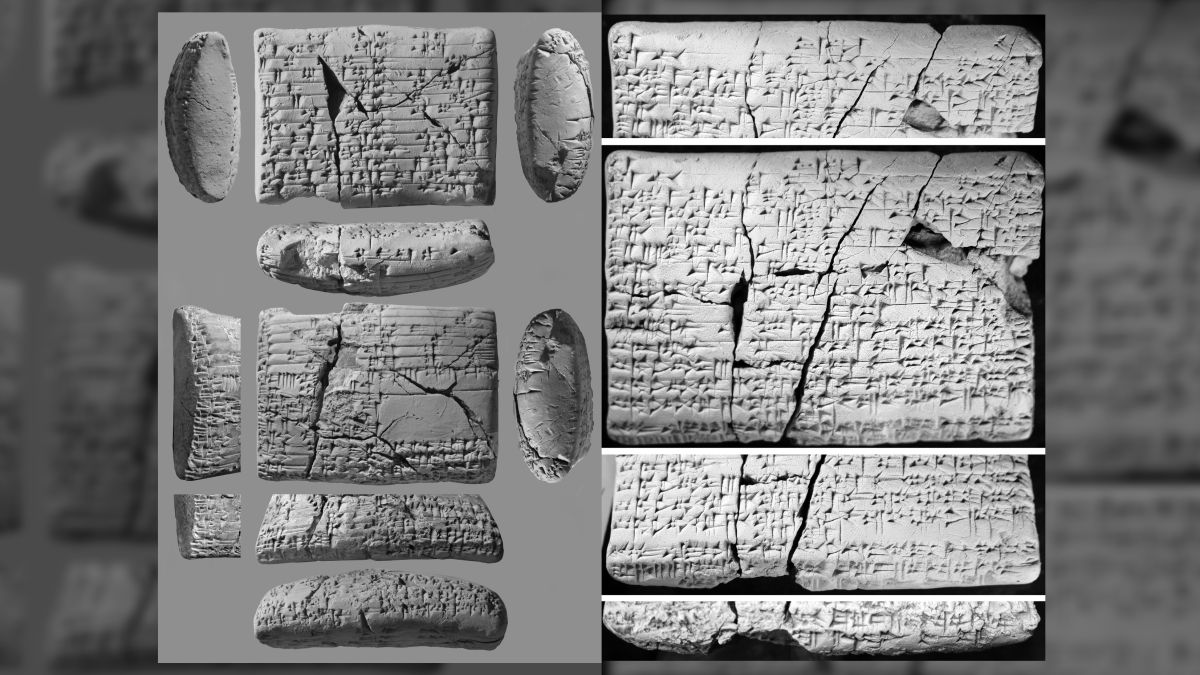Canaanite in the news again
« previous post | next post »

The 4,000-year-old tablets reveal translations for 'lost' language, including a love song.
(Image credit: Left: Rudolph Mayr/Courtesy Rosen Collection. Right: Courtesy David I. Owen)
From:
Cryptic lost Canaanite language decoded on 'Rosetta Stone'-like tablets
Two ancient clay tablets from Iraq contain details of a "lost" Canaanite language.
By Tom Metcalfe, Live Science, Jan. 30, 2023
First five paragraphs:
Two ancient clay tablets discovered in Iraq and covered from top to bottom in cuneiform writing contain details of a "lost" Canaanite language that has remarkable similarities with ancient Hebrew.
The tablets, thought to be nearly 4,000 years old, record phrases in the almost unknown language of the Amorite people, who were originally from Canaan — the area that's roughly now Syria, Israel and Jordan — but who later founded a kingdom in Mesopotamia. These phrases are placed alongside translations in the Akkadian language, which can be read by modern scholars.
In effect, the tablets are similar to the famous Rosetta Stone, which had an inscription in one known language (ancient Greek) in parallel with two unknown written ancient Egyptian scripts (hieroglyphics and demotic.) In this case, the known Akkadian phrases are helping researchers read written Amorite.
"Our knowledge of Amorite was so pitiful that some experts doubted whether there was such a language at all," researchers Manfred Krebernik (opens in new tab) and Andrew R. George (opens in new tab) told Live Science in an email. But "the tablets settle that question by showing the language to be coherently and predictably articulated, and fully distinct from Akkadian."
Krebernik, a professor and chair of ancient Near Eastern studies at the University of Jena in Germany, and George, an emeritus professor of Babylonian literature at the University of London's School of Oriental and African Studies, published their research describing the tablets in the latest issue of the French journal Revue d'assyriologie et d'archéologie orientale (opens in new tab) (Journal of Assyriology and Oriental Archaeology).
Two additional paragraphs on grammatical analysis:
By analyzing the grammar and vocabulary of the mystery language, they determined that it belonged to the West Semitic family of languages, which also includes Hebrew (now spoken in Israel) and Aramaic, which was once widespread throughout the region but is now spoken only in a few scattered communities in the Middle East.
After seeing the similarities between the mystery language and what little is known of Amorite, Krebernik and George determined that they were the same, and that the tablets were describing Amorite phrases in the Old Baylonian dialect of Akkadian.
Like a tourist guidebook:
Yoram Cohen (opens in new tab), an associate professor of Assyriology at Tel Aviv University in Israel who wasn't involved in the research, told Live Science that the tablets seem to be a sort of "tourist guidebook" for ancient Akkadian speakers who needed to learn Amorite.
One notable passage is a list of Amorite gods that compares them with corresponding Mesopotamian gods, and another passage details welcoming phrases.
Similarities to Hebrew and Akkadian:
Many of the Amorite phrases given in the tablets are similar to phrases in Hebrew, such as "pour us wine" — "ia -a -a -nam si -qí-ni -a -ti" in Amorite and "yeinam shiqiniti" in Hebrew — although the earliest-known Hebrew writing is from about 1,000 years later, Cohen said.
"It stretches the time when these [West Semitic] languages are documented. … Linguists can now examine what changes these languages have undergone through the centuries," he said.
Akkadian was originally the language of the early Mesopotamian city of Akkad (also known as Agade) from the third millennium B.C., but it became widespread throughout the region in later centuries and cultures, including the Babylonian civilization from about the 19th to the sixth centuries B.C.
It seems as though we are in the midst of a Canaanite boom.
Selected readings
- "ytš ḥṭ ḏ lqml śʿ[r w]zqt" (11/10/22)
- "'The world's oldest in-use writing system'?" (5/12/12)
- "Moloch and its countless congeners: the efflorescence of triliteralism" (5/29/22)
- "Unknown Language #13" (8/12/21)
- "Sally Rooney bucket hat; Hittite, Ugaritic, and the alphabet" (1/7/22)
- "Ashkenazi and Scythians" (7/13/21)
[Thanks to John Rohsenow]
David Marjanović said,
February 3, 2023 @ 7:34 pm
A bit of further discussion is scattered over this thread between the numerous digressions, and there's a link to the paywalled paper in the OP. Takeaways:
– the tablets are genuine;
– the language is definitely Northwest Semitic, but there doesn't seem to be anything specifically closer to Caananite in these texts than to Ugaritic or Aramaic;
– there's a bit of East Semitic mixed in, perhaps representing loans or bad translations from Akkadian, notably half of the sentences being in SOV order like Akkadian instead of VSO;
– "Amorite" is what anything West Semitic that shows up in Akkadian sources is traditionally called, so it may refer to any number of languages; most of the previously known material is just personal names anyway.